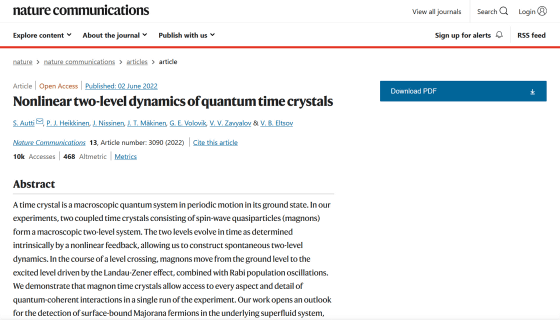Succeeded in observing 'time crystals' that break the laws of physics for more than 15 minutes, and gained momentum in quantum computer research.

A '
Nonlinear two-level dynamics of quantum time crystals | Nature Communications
https://doi.org/10.1038/s41467-022-30783-w

Time crystals “impossible” but obey quantum p | EurekAlert!
https://www.eurekalert.org/news-releases/954258
'Time crystals' work around laws of physics to offer new era of quantum computing | Space
https://www.space.com/time-crystals-quantum-computing
New time crystal experiment may open new horizons in quantum computing --The Jerusalem Post
https://www.jpost.com/science/article-709171
The concept 'time crystal' proposed by Frank Wilczek, a physicist at the Massachusetts Institute of Technology in 2012, is the physics law ' time-translation symmetry ' that a stable object does not change over time. It is the existence that breaks.
For example, ice in a stable ground state does not change, but only when it becomes unstable due to external factors such as temperature and pressure. However, the time crystal changes even in a stable ground state, and it is possible to permanently maintain the movement of the atom to vibrate and rotate even though there is no energy inflow and outflow from the outside.
'Everyone knows that perpetual motion is impossible, but as long as you keep your eyes closed in quantum physics,' said Samuli Autti, a physicist at Lancaster University in the United Kingdom who led the research team. Perpetual motion is possible. By sneaking through this crack, we can make time crystals. '

The research team of Autti et al. Created a time crystal in
The research team then created two time crystals that interact inside the superfluid and succeeded in observing them for a record time of about 1000 seconds (about 17 minutes). This is a very long time in terms of atomic vibrations in time crystals.
Furthermore, in this experiment, the two time crystals were linked, and it was possible to move the vibration of one to the other. 'During the experiment, we were able to cross the frequencies of two time crystals. When the frequencies were about the same, they interacted,' said Jere Mäkinen, a researcher at Aalto University in Finland. , Some of each amplitude moves to the other crystal. '
Linking multiple time crystals is said to be useful for the construction of quantum computers, and the results of this research will be a momentum for research on quantum computers. In this experiment, an extremely cold superfluid was used, but past studies have confirmed that time crystals can exist at room temperature, and there are high expectations for the development of quantum computers that operate at room temperature.

In a paper published on June 9, 2022, a team at the Institute of Laser Physics at the University of Hamburg reports that 'for the first time, we succeeded in realizing a time crystal that spontaneously breaks the time translational symmetry.'
Researchers observe continuous time crystal
https://phys.org/news/2022-06-crystal.html
Related Posts:
in Science, Posted by log1h_ik







